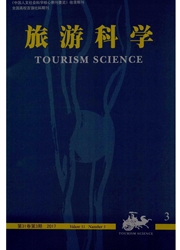

 中文摘要:
中文摘要:
随着全球竞争的不断加剧,地方政府着力于塑造城市形象以吸引外部资源,这种效率导向的建设行为扩大了城市内部的空间差异,并使得外地游客与本地居民的空间感知产生差异。本文以语义差别法(SemanticDifferential)为分析工具,通过对广东省佛山市南海区西部城镇的实证调查,比较分析了外地游客相对于本地居民对城镇感知的评价特征。分析发现,研究对象的空间感知总体呈现平庸化的格局,但是外地游客对城镇生态环境品质、城乡空间差别方面的空间感知评价均优于本地居民,且这种评价与实地场景照片内容具有内在的一致性。研究最后提出,对旅游城镇而言,地方政府往往重点建设外地游客高频活动区域,易忽视对本地居民日常生活场所的建设投资,从而导致了两类社会群体对空间感知的语境差异。
 英文摘要:
英文摘要:
With the increasing global competition, local governments focus on shaping the city' s image to attract external resources. The efficiency-oriented style of construction has a strong selective preference in space, which exacerbates urban internal spatial differences. With Semantic Differential method (SD) as the tool, this paper analyses evaluation features in urban perception of visitors compared with that of local residents based on empirical investigation in the western towns in Nanhai, Guangdong. It is found that spatial perception of the research objects generally shows a pattern of mediocre, and it has serious homogenization with the surrounding towns. However in the aspects of urban ecological environment and urban-rural spatial difference, spatial perception evaluation of visitors is superior to that of local residents and this evaluation has internal consistency with field scene photo. In fact the contextual difference on urban spatial perception reflects each spatial benefit of visitors and local residents. The research ends to warn that in tourist towns, local governments tend to ignore the investment of places for local residents' daily life by aim at enhancing the city' s image by setting the core area and the gateway landscape as the target region, in which the efficiency-oriented construction might lead to the contextual differences of two social groups' spatial perceptions.
 同期刊论文项目
同期刊论文项目
 同项目期刊论文
同项目期刊论文
 期刊信息
期刊信息
